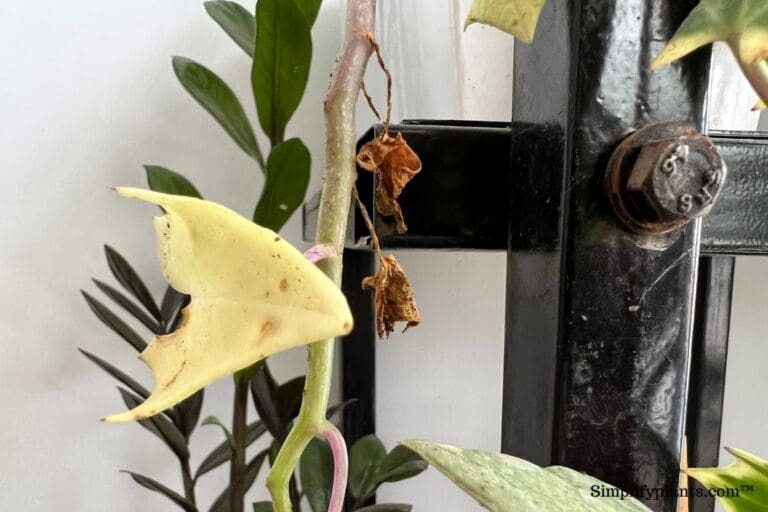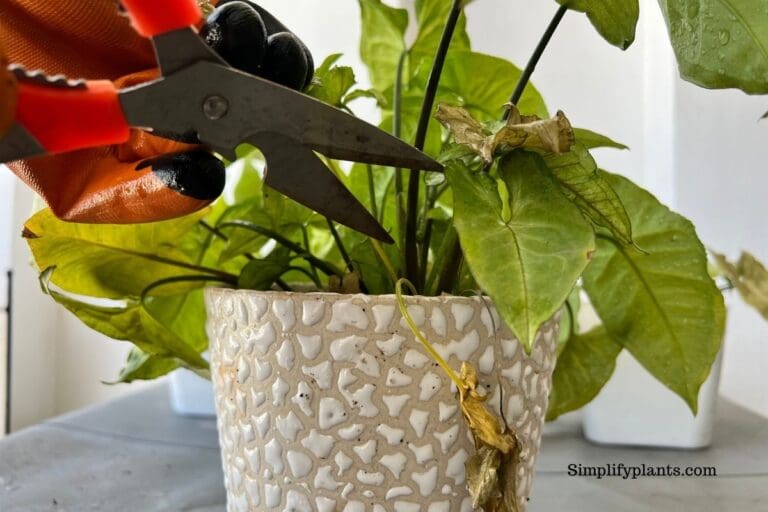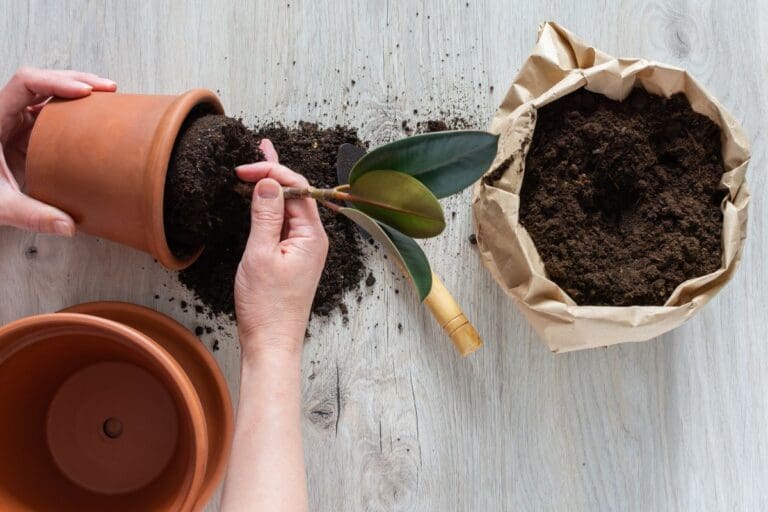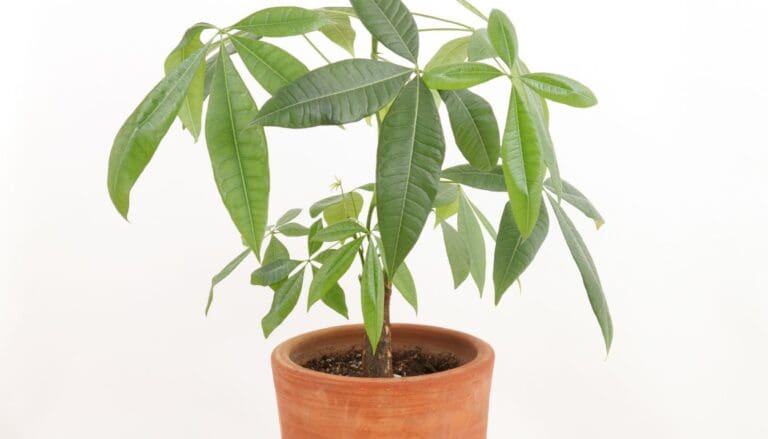Why Is My English Ivy Dropping Leaves? (Causes+How To Fix)
English ivy plants grow both indoors, and outdoor plants and can adapt to a large array of situations. However, one problem this plant often shows is dropping leaves, which shows the plant is undergoing some stress.
English ivy drops leaves due to incorrect watering, improper fertilization, pest or fungal infestations, and low light. Providing the plant with ideal growing conditions like sufficient light, correct watering, and appropriate soil mix will help to cure and prevent the problem.
This article will extensively discuss the various factors that lead to your English ivy losing its leaves and the solutions to treat those problems.

Please note: Simplify Plants is reader-supported. Some links in the post are affiliate links and I get a commission from purchases made through links in the post.
Why are my English ivy leaves falling off?
When your favorite houseplant begins to drop its gorgeous leaves, and you cannot understand its cause, it is heartbreaking.
Losing leaves is a sign that the plant has some problem, and you need to identify the cause to fix the problem.
When your English ivy undergoes unsuitable growing conditions like poor light, overwatering, pest infestations, poor soil mix, low humidity, etc., it warns you by shedding its leaves.
Now let us identify each cause that leads to leaf dropping and discuss the solution to each problem.
1. Incorrect watering
Watering is where most plant growers go wrong, resulting in unhealthy plants.
It is tricky to understand the ideal watering requirements of ivy plants, especially for beginners, which is why the plants suffer.
Both overwatering and underwatering are equally harmful to the health and the growth of English ivy.
Overwatering
Overwatering is dangerous for plants because it makes the soil soggy.
The excess moisture in the soil cuts off oxygen circulation, which leads to fungus growth in the soil.
If you keep your plant overwatered for a long time, it can result in root rot due to the roots being suffocated in the water.
Overwatered plants also become a breeding ground for fungus and pests as they thrive in damp conditions.
Signs of overwatering include wilting, mushy leaves, yellowing and browning of leaves, and soil that remains wet all the time.
Solution:
- Cut down on watering completely and wait for the soil to dry up.
- If the soil remains heavy, alter it with light, well-draining soil.
- Keep your English ivy at a spot where it will receive 3-4 hours of direct sunlight.
- If there are any fungal diseases, treat them and repot the plant in fresh soil.
- Always check the soil’s moisture content before watering.
- If your English ivy does not recover, take it out of the pot and inspect its roots for signs of root rot.
- If you find its roots mushy and black, trim them. Repot it in fresh soil, which is light and well-draining.
Underwatering
English ivy enjoys slightly dry soil.
But it does not mean you underwater them and keep them bone dry.
Underwatered English ivy plants become weak due to dehydration.
If the plant does not have enough moisture and energy to thrive, it will begin to lose its leaves to save energy.

Certain signs of underwatering include:
- Leave curling.
- Cracks on the soil surface
- Droopy wilted plants
- Yellowing of the leaves
Solution:
- Do not leave the soil bone dry.
- If you find the soil extremely dry and cracked, poke some holes in it with a chopstick to allow aeration.
- Water the soil thoroughly until the excess water runs out of the drainage holes.
- Or fill up a big tub with water and put the plant pot in it for 15-20 minutes, and let the soli soak all the moisture that it requires
- Keep the plant away from radiators, vents, heaters, etc., because these tend to suck up the moisture from the plants.
- Water the plant whenever you see the top layers of the soil are dry.
- If you forget to water often, you can invest in self-watering pots to prevent underwatering.
2. Low humidity
English ivy thrives in humidity and cannot tolerate very dry air.
Dry air makes the plant dehydrated and feeble, which results in the plant shedding leaves.
English ivy plants require at least 40% humidity to grow.
If the humidity is lower, the plant will have difficulty adjusting.
Since the air indoors is drier than outdoors, it is difficult to give the plant the required humidity naturally.
In dry air, the plant leaves curl to save moisture loss via transpiration.
Low humidity is mostly witnessed in the winter when the air is extremely dry and cold.
Some signs that your ivy is not getting enough humidity are crispy leaves, shriveled leaves, droopy plants, etc.
Fix:
- Misting helps in giving humidity to the plant. But always mist in the morning so that the water dries off.
- Installing a humidifier is an effective way to increase humidity indoors. Here is my favorite humidifier, which you will get at an affordable rate: LEVOIT Humidifiers for Bedroom.
- Pebble trays are another good option where a tray filled with pebbles and water is kept below the pot to keep the humidity high.
- Grouping all the humidity-loving plans together helps in the transpiration of the plants.
- Keep the plant away from heaters and AC, which tend to suck up the moisture from the plant.
3. Temperature fluctuations
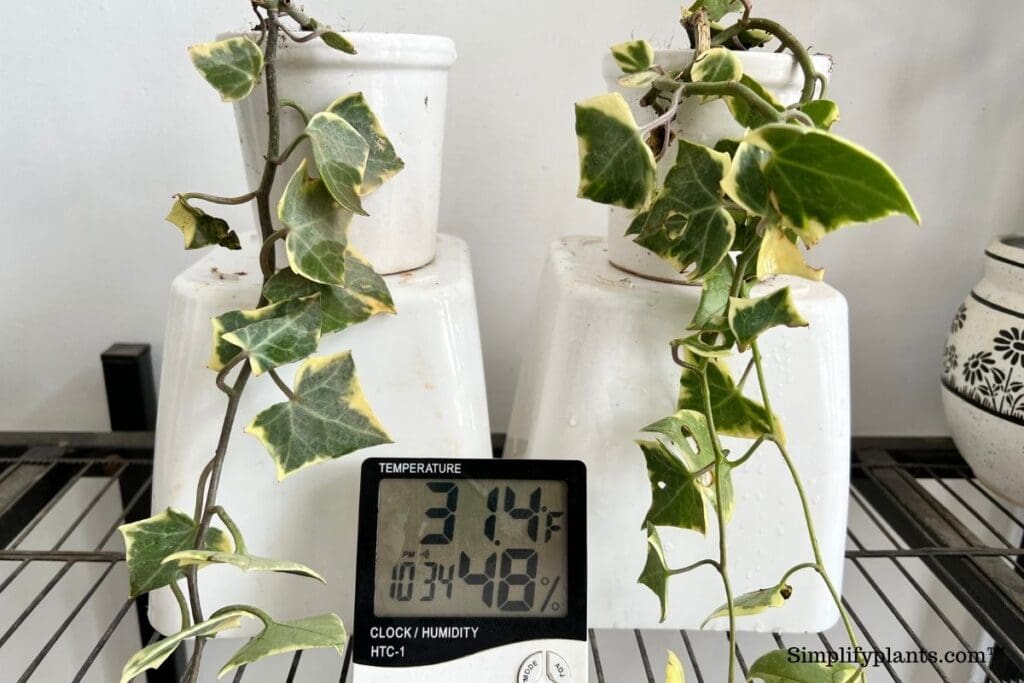
The ideal temperature range for the English ivy plant is between 70-90°F.
English ivy plants are sensitive to extremely high or cold temperature ranges.
They cannot tolerate harsh frost or very hot weather.
Frost and harsh cold can injure them, leading to brown spots and stunted growth.
This is why the growth of the ivy plant reduces significantly in winters due to conditions like low light, cold temperature, and dry air.
Frequent fluctuations in temperature put the ivy under stress and shock the plant, which leads them to lose their leaves, turn the plant yellow, and cause stunted growth.
Extreme hot weather dehydrates the plant making it yellow and dry, leading to leaves dropping.
And too cold temperatures can restrict the plant’s nutritional access.
Let us read about the solutions to prevent this problem.
Fix:
- Keep the English ivy away from spots with temperature fluctuations.
- Do not keep the plant near air conditioners.
- Keep them away from heaters, chimneys, etc.
- Avoid keeping the ivy near doors and windows frequently opened and closed.
- Do not keep the plant near glass window panes where the leaves will get rubbed against the glass.
- Do not change the location of your plant frequently as it puts them under unnecessary stress of adapting to the new environment.
4. Low light

Light is most important for plants to make their energy and food.
With insufficient light, the plant’s capacity to make food decreases.
Insufficient light reduces the plant’s energy, making the leaves fall off the plant.
Low light conditions also increase the chances of fungal growth and pest in the plant as the soil, and the leaves stay wet for a longer time, and most fungi and pests enjoy wet soil to thrive.
Fix:
- Give your English ivy at least 4-6 hours of direct sun.
- Keep your ivy in an east-facing or south-facing window or balcony where they would get the maximum bright light.
- If you think your home lacks sufficient light, install artificial lights near your plants.
- During winters, try keeping the ivy plant under full sunlight.
- Rotate the plant weekly so that all the sides of your plant get even light. This prevents the plant from bending on one side or getting leggy.
- Keep ample space between each plant so that they get light and airflow.
5. Wrong potting soil

The soil mix you prepare for your potted plants is important as the growth and health of the plant depend on that.
Plants growing on the grounds have direct access to nutrients and food in the soil, but plants in the pots are restricted to the soil only to get their nutrients.
Thus, rich, nutritious potting soil is necessary if you want your English ivy plant to prosper.
If the soil is clayey and heavy and retains a lot of water, it will become unsuitable for the plant.
Ivy plants require soil that is light, loamy, and has excellent drainage.
The soil needs to have airflow so that the roots can breathe.
Compact and heavy soil suffocates the roots and gives rise to fungi growth.
The soil also needs nutrients like calcium, magnesium, phosphorous, potassium, iron, nitrogen, etc., so the plant gets all the macro and micronutrients required to flourish and grow.
If the soil cannot fulfill these needs of the plant, then it will hamper the plant’s growth, and it can end up losing leaves.
Fix:
Always prepare the soil in a way that does not hold unnecessary moisture and allows air circulation in the soil.
Here is a recipe for an ideal soil mix for your English ivy:
- 2 parts potting soil
- 1 part compost
- 1 part perlite/sand/vermiculite
- 1 part peat moss/coco peat
- A handful of crushed charcoal
Compost improves the quality of the soil and adds nutrients like nitrogen, potassium, and phosphorous to the soil.
Sand or perlite improves drainage in the soil and does not let the soil get clumpy.
Peat moss helps the soil retain some necessary moisture, so the soil does not get bone dry.
Charcoal allows air circulation in the soil, so the soil does not get too tight.
6. Improper fertilization

Fertilizer supplements are useful for your plants as they provide the necessary minerals and nutrients that the soil tends to lose with regular watering and erosion.
Lack of nutrients makes the plant grow weak and stunts its growth, losing its leaves.
At the same time, too much and too frequent fertilizer can also damage your plant by burning its roots.
When the roots are injured, it fails to supply essential nutrients to the plant resulting in a weak plant that loses its leaves fast.
Fix:
- Fertilize your English ivy with an NPK 20-20-20 fertilizer in the growing season.
- Feed your ivy with a slow-release fertilizer once in March and once in September.
- If you think you have over-fertilized your ivy, you must stop fertilizing immediately.
- Then water the soil of your ivy 3-4 times until all the water drains out, which will help wash the fertilizer.
- If the plant still does not recover and you notice white salts on the soil surface, repot the plant in a new fresh soil mix.
- Do not fertilize your English ivy in winters. This is because, during this season, its growth reduces drastically, so fertilizing can leave salt accumulation in the soil burning the roots of the plant.
- You should only fertilize during the growing season.
7. Pest infestations

The biggest nightmare for plant growers is probably pest infestations.
Once your plant gets heavily infested by pests, it is difficult to get rid of them as they are highly contagious and spread from one plant to another in a matter of days.
These nasty pests attach themselves to your ivy and feed on the plant’s sap, which contains the necessary nutrients and energy for the plant.
As a result, the plant grows weaker, and the leaves start falling.
If these pests are found in the initial stages, it is easier to get rid of them, but sometimes when the infestation has progressed to the entire plant, you may lose it.
Unsuitable conditions like too much humidity, damp conditions, lack of airflow, low lights, etc., attract pests.
Fix:
- First, isolate the plant from the others as the bugs spread quickly.
- If you notice any pest in your ivy, do not postpone and start the treatment immediately.
- Dip cotton in rubbing alcohol and wipe the infected parts of the leaves.
- If the infestation is over a larger area, prune off the heavily infested parts.
- Then wash your ivy under running water.
- Then bring it outside under bright light to dry off.
- Once the leaves are dry, spray Neem oil mixed in water generously over the entire plant and repeat this 3-4 times.
- You can mix liquid soap with water and spray it all over the plant.
- If your infestations refuse to clear up even after this, spray pesticides carefully after reading the instructions.
To prevent further pest attacks, here are a few tips you must follow:
- Do not keep the plant in damp conditions.
- Always mist or spray in the morning, so the leaves are dry by night.
- Make sure your plant gets a lot of bright light.
- Do not keep the plant in a corner without airflow or sufficient ventilation.
- It is recommended to spray your plant with Neem oil periodically.
8. Natural aging

If you notice the ivy is shedding older leaves, you need not worry, as plants dropping old leaves and growing new leaves in their place is a natural cycle.
The older leaves take up a lot of the plant’s energy, so when they no more have the energy to hold themselves to the plant, they naturally fall off.
They gradually turn yellow and then brown and begin turning dry and crispy before falling off.
This helps the plant to utilize its energy in pushing more healthy growth.
Final words
If you find your English ivy dropping leaves quickly and not growing new leaves, you must act immediately and try to find what’s wrong. By inspecting the plant thoroughly, you will be able to identify the causes behind the problem and take possible actions.
But if you see only the old leaves are shedding, do not worry. Try giving the perfect growing environment to your English ivy, and you can keep it healthy and happy.
Reference: Researchgate, University of Tennessee, Mississippi State University, Central Florida Research and Education Center, U.S. DEPARTMENT OF AGRICULTURE.
Recommended Garden Supplies
| Product Image | Our Recommended Gardening Supplies | Check Offers! |
|---|---|---|
Top Top
Top
Top
Top
Top
Top
Top
Top | rePotme Houseplant and Tropical Classic Potting Soil Mix | Check Offer On Amazon |
 Top
Top
Top
Top
Top
Top
Top
Top | Espoma Organic Indoor Plant Food | Check Offer On Amazon |
 Top
Top
Top
Top
Top
Top
Top
Top | GooingTop LED Grow Light 6000K Full Spectrum Clip Plant Growing Lamp | Check Offer On Amazon |
 Top
Top
Top
Top
Top
Top
Top
Top | Soil Moisture Meter | Check Offer On Amazon |
 Top
Top
Top
Top
Top
Top
Top
Top | Govee Hygrometer Thermometer, Bluetooth Enabled! | Check Offer On Amazon |
 Top
Top | LEVOIT Humidifiers for Large Room(Best For Plants) | Check Offer On Amazon |
 Top
Top
Top
Top
Top
Top
Top
Top | Upgraded DIY Automatic Drip Irrigation Kit, 15 Potted Houseplants Support | Check Offer On Amazon |
 Top
Top
Top
Top
Top
Top
Top
Top | Stainless Steel Heavy Duty Gardening Tool Set | Check Offer On Amazon |
 Top
Top
Top
Top
Top
Top
Top
Top | Bonide Insecticidal Soap | Check Offer On Amazon |
 Top
Top
Top
Top
Top
Top
Top
Top | Bonide 32 oz Spray Neem Oil for Organic Gardening | Check Offer On Amazon |
 Top
Top
Top
Top
Top
Top
Top
Top | Garden Safe Fungicide | Check Offer On Amazon |

